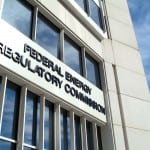The Federal Energy Regulatory Commission (FERC) set a three-week window for comment on the proposed Department of Energy (DOE) grid resiliency rule that 11 power trade groups—representing natural gas, wind, solar, public power, and power consumers—worry could have serious ramifications for competitive markets because it favors coal and nuclear.
The groups filed a joint motion on October 2 urging FERC to consider stakeholder input as it determines whether and how it will move forward with the DOE’s directive to implement the measure. FERC, though, also on October 2 published a notice inviting comments on the proposed rule before October 23, and reply comments before November 7.
Bitter Power Sector Dispute Brewing
The DOE’s “Grid Resiliency Pricing Rule” proposed on September 29 directs FERC—an independent regulatory government agency that is officially organized as part of the DOE—to exercise its authority under sections 205 and 206 of the Federal Power Act and require that independent system operators (ISOs) and regional transmission organizations (RTOs) “establish just and reasonable rates for wholesale electricity sales” for power plants that show “reliability and resiliency attributes.”
The DOE directed FERC to take action on the rule within 60 days, or impose an interim final rule immediately—with a provision for “later modifications” after a 45-day public comment period. The rule also requires that ISOs and RTOs submit a compliance filing within 15 days after the DOE finalizes the rule.
The 11 trade groups representing natural gas, wind, solar, public power, rural cooperatives, and power consumers that filed the motion with FERC on October 2 include:
- Advanced Energy Economy
- American Council On Renewable Energy
- American Petroleum Institute
- American Public Power Association
- American Wind Energy Association
- Electricity Consumers Resource Council
- Electric Power Supply Association
- Interstate Natural Gas Association of America
- National Rural Electric Cooperative
- Natural Gas Supply Association
- Solar Energy Industries Association.
“This is one of the most significant proposed rules in decades related to the energy industry and, if finalized, would unquestionably have significant ramifications for wholesale markets under the Commission’s jurisdiction,” the groups said in the joint motion. The rule could also affect electricity prices paid by “hundreds of millions of consumers and hundreds of thousands of businesses, as well as entire industries and their tens of thousands of workers,” they said.
The group’s motion specifically contests the DOE’s “aggressive time frame” for consideration of the proposed grid resiliency pricing rule, urging FERC to provide the groups at least 90 days for comment. It also calls on FERC to convene a technical conference before the comment deadline to help interested parties better understand the rule.
The motion, however, also notes that the DOE’s directive for an interim rule wasn’t established within the narrow provision for such rules in the Administrative Procedure Act (APA). “As a result, the Commission should not pursue this alternative,” it suggests.
The APA’s “good cause” exemption that would justify FERC’s publication of an interim final rule without first publishing a proposed rule is generally “limited to emergency situations,” and it should be “narrowly construed and rarely countenanced,” the motion notes. It means that FERC would need to establish the existence of an emergency, give prior notice to overturn the underlying statutory framework, or show that Congress intends to waive notice and rulemaking requirements for comment. But “None of these circumstances exists such that the extraordinary use of an interim final rule would be justified,” the motion says.
No Reliability Emergency Exists
The motion highlights the DOE’s own controversial 187-page grid study released this August and statements by the North American Electric Reliability Corp. (NERC) to categorically conclude that no reliability emergency exists.
It notes that grid study underscores: “reliability is adequate today despite the retirement of 11 percent of the generating capacity available in 2002, as significant additions from natural gas, wind, and solar have come online since then.”
It also quotes NERC CEO Gerry Cauley as saying at the May 2017 FERC’s Reliability Conference that “the state of reliability in North America remains strong, and the trend line shows continuing improvement year over year.”
The Pushback Widens
A number of power trade groups, independent power producers, and environmental groups outside the 11 parties that filed the motion have expressed concerns about the rule that they say could disrupt market competition in favor of “fuel secure” generation—which includes “power plants that can “withstand major fuel supply disruptions caused by natural or man-made disasters and, in those critical times, continue to provide electric energy, capacity, and essential grid reliability services,” according to the proposal.
A large number of “fuel secure” plants have retired or are scheduled to retire, the rule says, and while it doesn’t outright define coal and nuclear plants as “fuel secure,” it points mainly to statistics concerning coal and nuclear retirements to bolster concerns that their retirements may impact resiliency and reliability.
According to Jason Johns, a partner at law firm Stoel Rives who often appears before FERC, it’s clear that the proposed rule is “crafted for coal.” The DOE’s prolific use of the term “fuel secure generation” could also include nuclear, “but who are they kidding?” he said.
“Renewable resources are nowhere in this proposal, and it’s clear from the notice that DOE intended this to prop up coal power,” he said in a statement to POWER on October 3. The notice also “surgically carves natural gas generators out of the money by referring to the natural gas shortages that affected power generation during the Polar Vortex.” Yet, he noted, “This has no direct impact on renewables, other than how any payment for ‘resiliency’ might allow coal or nuclear resources to underbid renewables in the market.”
But for Johns, what is truly remarkable about the notice is the manner in which it was issued. “It utilized a rarely-used statute to cause one agency to order another to take action, and on a very fast timeline. It’s arguably illegal as a violation of the Administrative Procedures Act,” he said.
PJM Confident Competitive Markets Can Achieve DOE Resiliency, Reliability Objectives
On October 2, PJM Interconnection, the entity that operates the largest U.S. competitive wholesale market, told POWER that it has “achieved the objective of ensuring reliable power supplies at the lowest reasonable cost–and the PJM region includes both cost-of-service states and states with retail competition,” for more than 20 years.
The DOE’s objectives in the proposed rule “can be achieved through competitive markets,” it said. “The markets have a successful track record of paying for performance so that consumers benefit from the most effective and efficient resources.” It added that the DOE’s concerns with ensuring fuel security, resilience, and proper pricing of reliability attributes are aligned with PJM’s efforts.
“Capacity Performance, for example, has worked to ensure secure fuel supplies and improvements to ensure generator availability,” it said. “PJM has been focused on fuel security, and we already have several proposals on energy price formation to better ensure that market prices transparently value reliability attributes that we believe provide a superior solution.”
FERC should instead work to address energy price formation “by expanding the scope of its existing price formation efforts to include more accurate pricing for reliability attributes of all resources,” it said.
—Sonal Patel is a POWER associate editor (@sonalcpatel, @POWERmagazine)










